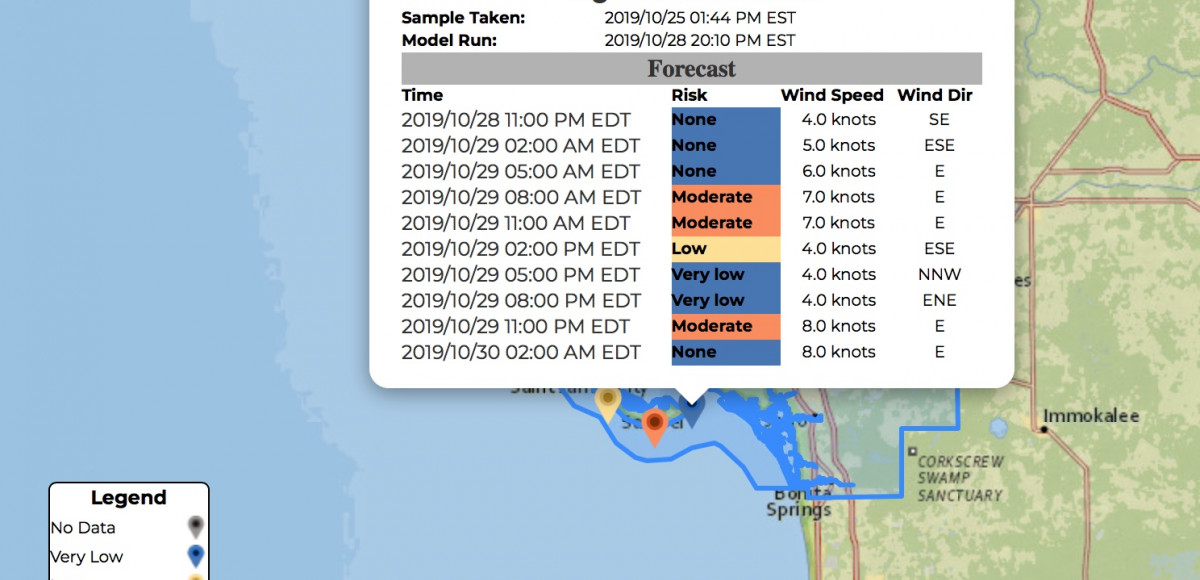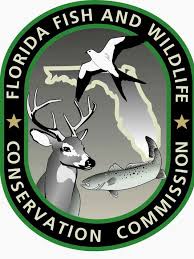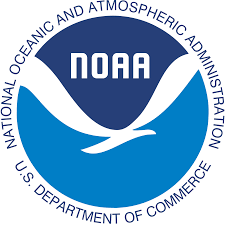
Sanibel Island residents and visitors who are susceptible to the respiratory impacts of Florida’s red tide — especially people with asthma and other chronic lung diseases — now have a new tool that will help them assess what day and time to visit three local beaches during red tides.
The Gulf of Mexico Coastal Ocean Observing System (GCOOS) website (habscope.gcoos.org/forecasts) now provides a risk-level forecast for red tide respiratory impacts on Bowman’s, Lighthouse and Tarpon beaches. The 24-hour Red Tide Respiratory Forecasts are updated every three hours, following the collection and analysis of water samples. The forecast will typically be available on Tuesdays, Thursdays, Saturdays and Sundays.
The Red Tide Respiratory Forecast was initially implemented in Pinellas County in 2018 thanks to a grant from NASA’s Applied Science Program through the Health and Air Quality Program. It was developed by NOAA’s National Centers for Coastal Ocean Science (NOAA-NCCOS) in partnership with GCOOS and the Florida Fish and Wildlife Conservation Commission-Fish and Wildlife Research Institute (FWC-FWRI).
Local partners helping to implement it on Sanibel include the Sanibel-Captiva Conservation Foundation (SCCF), Sanibel Sea School and the City of Sanibel. The Lee County Department of Natural Resources and Lee County Environmental Lab are also partners on the project and have been collecting samples for red tide identification that have been used in red tide forecasts and reports about public beaches since 2006.
Karenia brevis, the marine organism that causes red tide, can have negative impacts on the human respiratory system. Most people experience minor respiratory irritation — coughing, sneezing, teary eyes and an itchy throat — when red tide is present and winds are blowing onshore. Typically, these symptoms go away when they leave the beach.
But people with chronic lung problems like asthma and chronic obstructive pulmonary disease (COPD) can have more severe reactions when they breathe in airborne red tide toxins — even ending up in the emergency room. Health officials advise that these people avoid areas experiencing red tide altogether, take all medications as prescribed and have access to rescue inhalers. People with chronic lung disease should leave the beach if they begin experiencing respiratory problems, even if red tide is at very low or low concentrations.
“Red tide impacts can be really variable because of wind patterns,” said Dr. Barbara Kirkpatrick, Executive Director of GCOOS and an environmental health scientist who conducted the first studies documenting the impacts of Florida red tide blooms on human health. “There are very few days when all beaches will be affected by red tide, and often your favorite beach is only affected for part of the day. This new forecast lets people see which beaches might be impacted by red tide and at what time of the day, allowing them to plan their beach walks and other outdoor activities accordingly. They can use this tool the same way they use other weather reports.”
HABscope
Key to creating the Red Tide Respiratory Forecast is a new tool, dubbed “HABscope,” a portable microscope system that uses video and artificial intelligence (AI) to quickly analyze water samples for near real-time cell counts of Karenia brevis.
To develop HABscope, researchers took a low cost, classroom-grade, portable microscope, outfitted it with a special adaptor — designed by the team’s engineer and printed on a 3D printer — then used that piece to mount an Apple iPOD touch to the eyepiece of the microscope. A portable power pack provides the power to light the microscope.
For the forecast, a researcher or citizen science volunteer first collects a water sample, places it under the microscope and uses the iPOD touch to take a video. Then, the video is uploaded GCOOS, which developed a special program that uses artificial intelligence to automatically identify Karenia brevis cells in the water sample as well as the number of cells present — the concentration of cells. The automated process reports its findings to researchers making red tide forecast models.
In 2004, the NOAA’s National Ocean Service and partners started issuing twice-weekly condition reports and bulletins that identified the risk of respiratory irritation for three-to-four-day periods on a county-by-county level. The information is now released through the National Weather Service’s regular Beach Hazard Statement alerts. This new Experimental Red Tide Respiratory Forecast builds on NOAA’s condition reports and bulletins by providing information at a finer scale — at the beach level, not just the county level.
“Now, thanks to the water testing being done by our partners at Sanibel-Captiva Conservation Foundation and the Sanibel Sea School, we’re able to refine our forecasts and offer predictions on a beach-by-beach basis,” said Dr. Richard Stumpf, NOAA-NCCOS Oceanographer who led the forecast development team. “This forecast is the first step toward reducing the health and economic impacts of red tides for coastal communities. Red tide should be an inconvenience, not a crisis.”
The addition of HABscope will be helpful to residents and visitors, said Dr. Eric Milbrandt, SCCF Marine Lab Director. “Until now, respiratory forecasts have previously been published weekly. Now, we have effective, real-time forecasts updated several days per week that will now allow our residents and visitors to plan their trip to the beach to avoid respiratory irritation. It is great to be able to contribute locally to provide information on red tide blooms in a practical and understandable way.”
NOAA has also launched a new satellite-monitoring product for Florida that provides satellite imagery of Florida’s coastal blooms over the last 14 days. These data are available to the public and will allow resource managers at the local and state levels to conduct targeted water sampling to better respond to bloom events.
“We have an obligation to the community to inform them of potential health impacts from shore-based ocean activities in the area that we are capable of monitoring,” said Dr. J. Bruce Neill, Executive Director of the Sanibel Sea School. “As a business dependent upon visitor revenue, we believe that informing the public is the right business approach. We want people to make informed choices and be able to rely on us to give them the appropriate data. We may lose short-term revenue, but we will gain long-term confidence and value.”
The Next Step
The next step will be to find additional funding to continue to support the Red Tide Respiratory Forecast and to expand it to other parts of Florida, GCOOS’s Kirkpatrick said. “When we initially discussed having a beach-level forecast for respiratory impacts, we knew it would need to rely on low-cost tools and be as automated as possible to allow for trained volunteers to be able to work with scientists and forecasters. We accomplished our goal and are now looking for governmental and non-governmental organizations to partner with us to keep the forecast going and to expand it to other parts of Florida and other regions along the Gulf Coast. While others work on a better understanding of red tides, we believe this low-cost tool and forecast system will help to keep people healthy and mitigate impacts on coastal communities.”




















